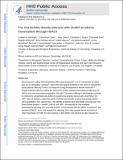The Xist lncRNA interacts directly with SHARP to silence transcription through HDAC3
Author(s)
McHugh, Colleen A.; Chen, Chun-Kan; Chow, Amy; Surka, Christine F.; Tran, Christina; McDonel, Patrick; Pandya-Jones, Amy; Blanco, Mario; Burghard, Christina; Moradian, Annie; Sweredoski, Michael J.; Shishkin, Alexander A.; Su, Julia; Hess, Sonja; Plath, Kathrin; Guttman, Mitchell; Lander, Eric Steven; ... Show more Show less
DownloadLander_The Xist.pdf (4.929Mb)
OPEN_ACCESS_POLICY
Open Access Policy
Creative Commons Attribution-Noncommercial-Share Alike
Terms of use
Metadata
Show full item recordAbstract
Many long non-coding RNAs (lncRNAs) affect gene expression, but the mechanisms by which they act are still largely unknown. One of the best-studied lncRNAs is Xist, which is required for transcriptional silencing of one X chromosome during development in female mammals. Despite extensive efforts to define the mechanism of Xist-mediated transcriptional silencing, we still do not know any proteins required for this role. The main challenge is that there are currently no methods to comprehensively define the proteins that directly interact with a lncRNA in the cell. Here we develop a method to purify a lncRNA from cells and identify proteins interacting with it directly using quantitative mass spectrometry. We identify ten proteins that specifically associate with Xist, three of these proteins—SHARP, SAF-A and LBR—are required for Xist-mediated transcriptional silencing. We show that SHARP, which interacts with the SMRT co-repressor that activates HDAC3, is not only essential for silencing, but is also required for the exclusion of RNA polymerase II (Pol II) from the inactive X. Both SMRT and HDAC3 are also required for silencing and Pol II exclusion. In addition to silencing transcription, SHARP and HDAC3 are required for Xist-mediated recruitment of the polycomb repressive complex 2 (PRC2) across the X chromosome. Our results suggest that Xist silences transcription by directly interacting with SHARP, recruiting SMRT, activating HDAC3, and deacetylating histones to exclude Pol II across the X chromosome.
Date issued
2015-04Department
Massachusetts Institute of Technology. Department of BiologyJournal
Nature
Publisher
Nature Publishing Group
Citation
McHugh, Colleen A. et al. “The Xist lncRNA Interacts Directly with SHARP to Silence Transcription through HDAC3.” Nature 521.7551 (2015): 232–236.
Version: Author's final manuscript
ISSN
0028-0836
1476-4687